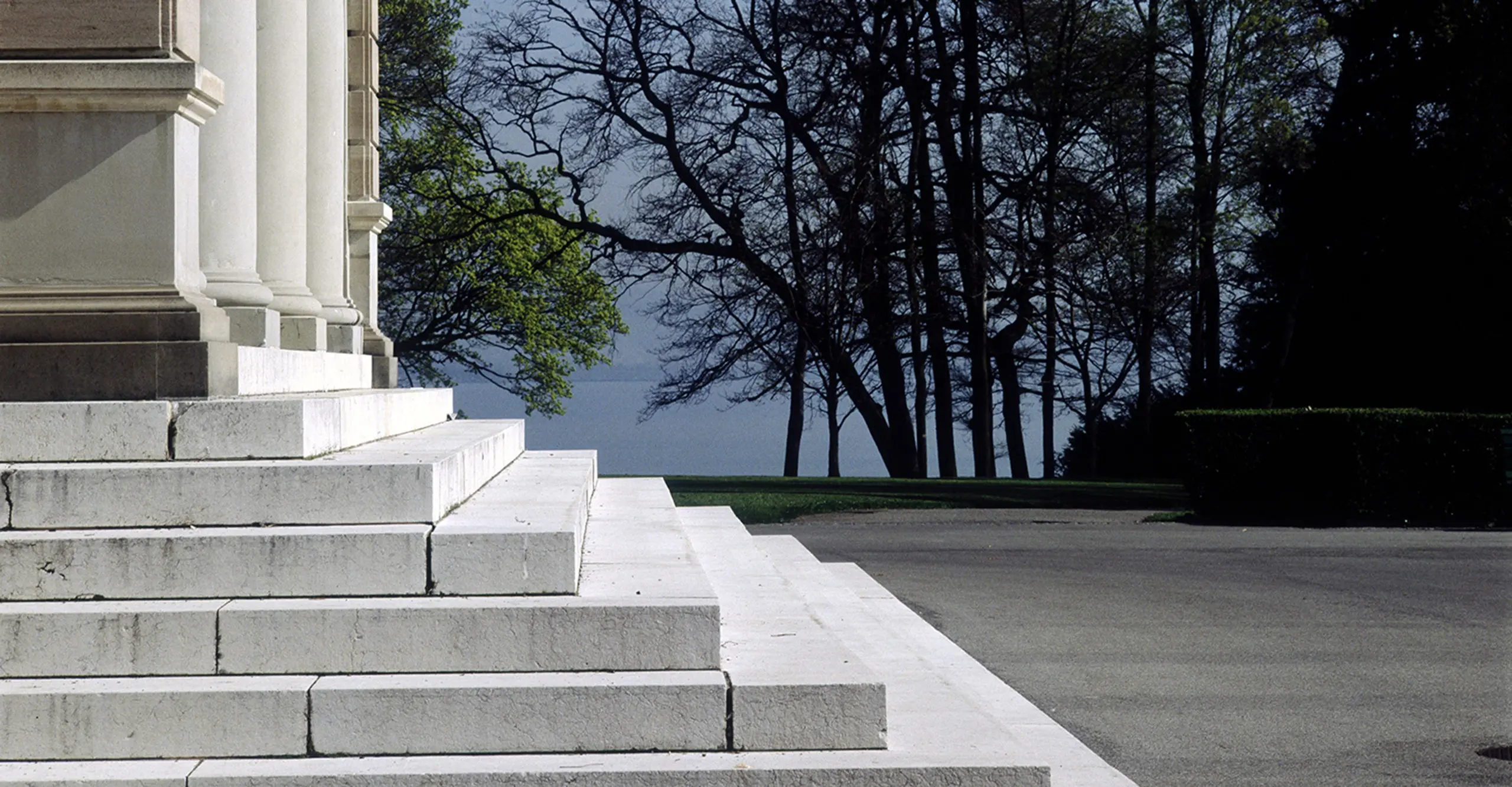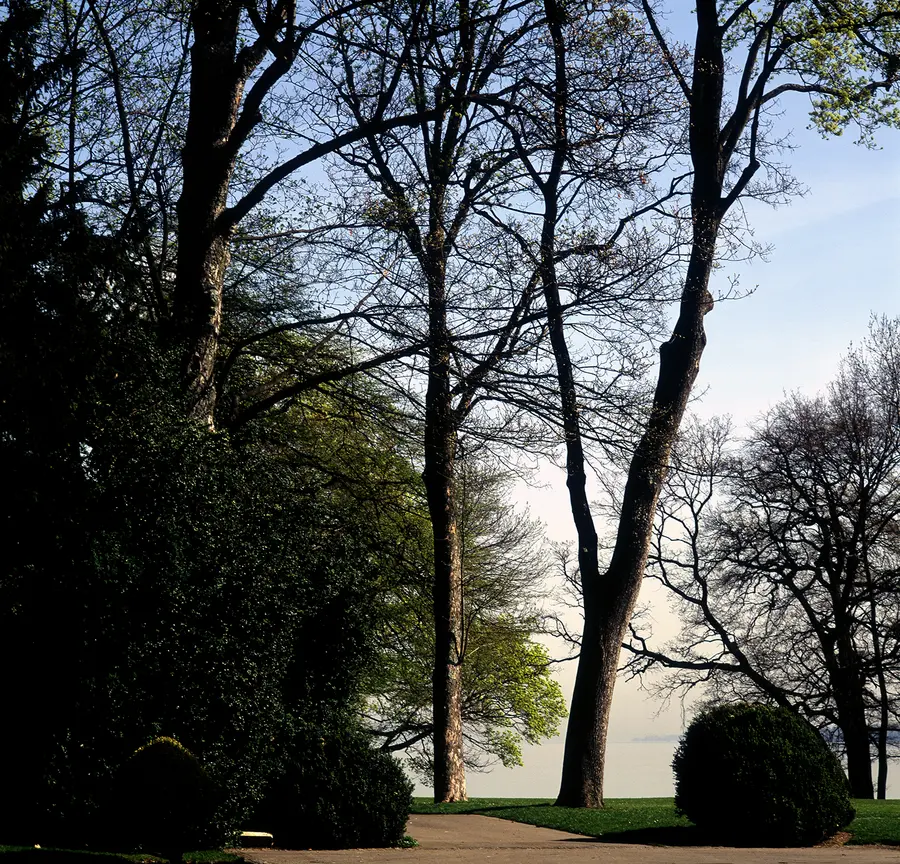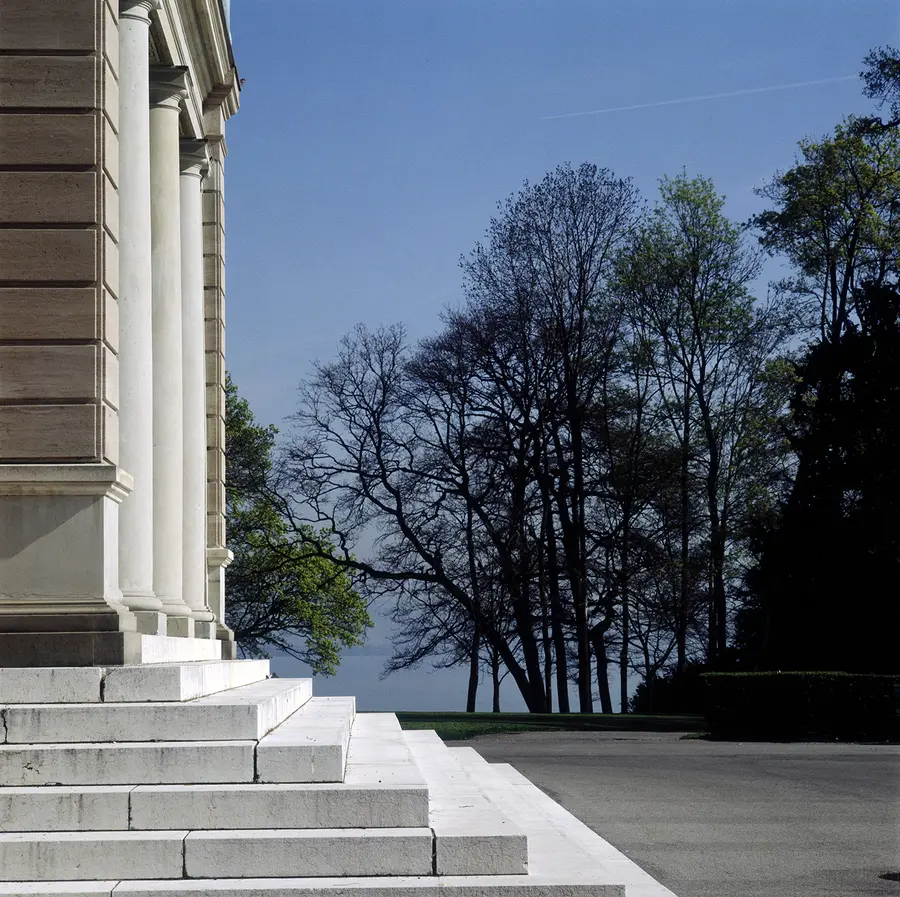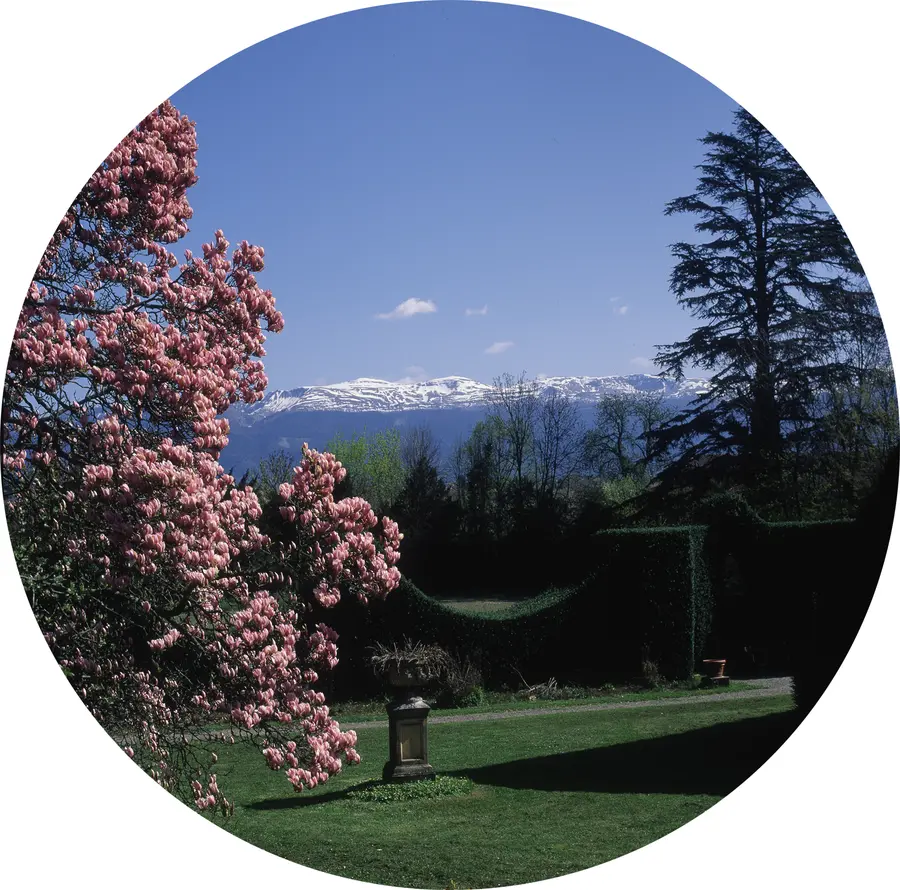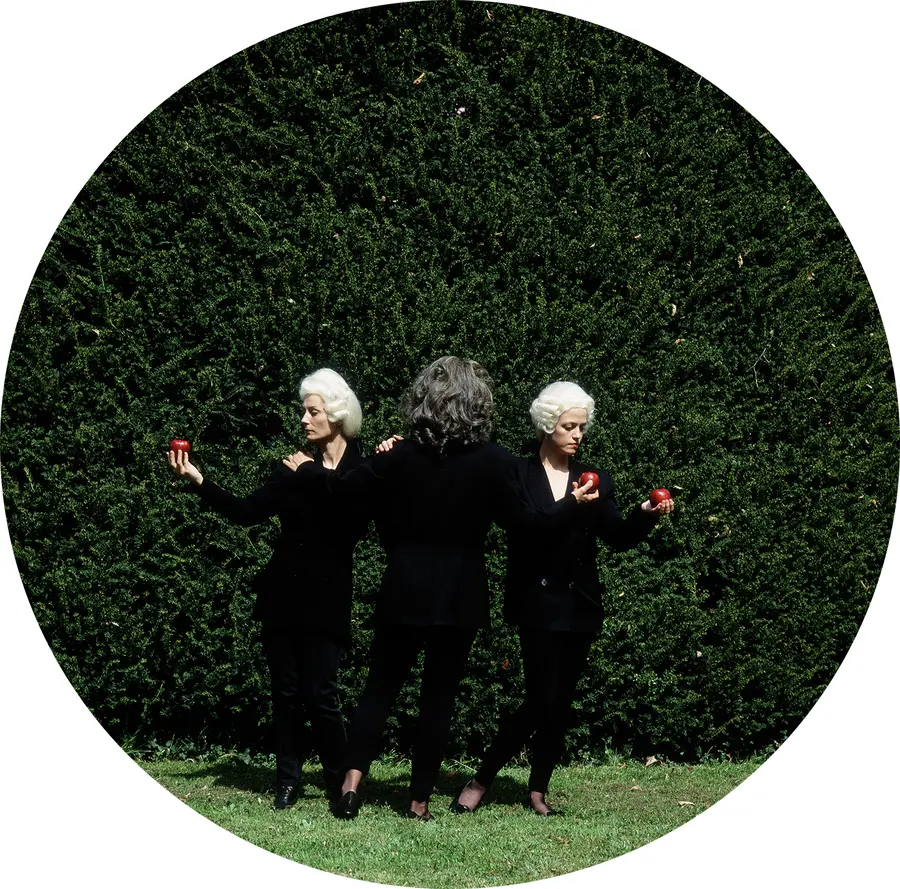NOW MY DEAR PANGLOSS TELL ME THIS:
WHEN YOU HAVE BEEN HANGED,
DISSECTED AND BEATEN UNMERCIFULLY,
DID YOU STILL THINK THAT EVERYTHING
IN THIS WORLD IS FOR THE BEST?
Voltaire - Candide (1759)
FRIENDSHIP IS A SERIOUS AFFECTION
THE MOST SUBLIME OF ALL AFFECTIONS.
BECAUSE IT IS FOUNDED ON PRINCIPLE
AND CEMENTED BY TIME.
THE VERY REVERSE CAN BE SAID OF LOVE.
Mary Wollstonecraft - A Vindication of the Rights of Woman (1792)
SACRED BE THE FEELINGS OF THE HEART!
CONCENTRATED IN A GLOWING FLAME,
THEY BECOME THE SUN OF LIFE.
WITHOUT HIS INVIGORATING IMPREGNATION,
REASON WOULD PROBABLY
LIE IN HELPLESS INACTIVITY,
AND NEVER BRING FORTH HER
ONLY LEGITIMATE OFFSPRING — VIRTUE.
Mary Wollstonescraft - A Vindication of the Rights of Men (1790)
The Virtues and the Delights is a bilingual work in French and English produced between 1992-1994 and commissioned by the Cross Channel Photographic Mission (now Photoworks) and Ferney Voltaire. It celebrates Mary Wollstonecraft’s feminist text published in 1792, A Vindication of the Rights of Woman and her alliances and disputes with Enlightenment philosophers such as Rousseau, Voltaire and other early feminists such as Emilie Chȃtelet, Louise d’Epinay and Mary Astell. Fellow travellers to the feminist cause were such thinkers as Condorcet and Paine and this work vindicates the collaboration and dialogue between male and female freethinkers in the 18th century.
The series addresses the picturesque genre in landscape as a space in between the masculine (sublime) and the feminine (beauty). The characters are androgyne – an 18th century wig and contemporary garb – a few objects to signify a tongue-in-cheek allegorical figure in the landscape. Actors and artist friends including myself are staged in the picturesque landscape surrounding Lake Geneva and Ferney Voltaire.
There are text transfers which are transferred directly onto the wall of fragments of the texts alluded to in the English titles of the work. The title the Virtues and the Delights alludes to the utopian hope that one can reconcile pleasure with duty and reason with emotion. The scale of the work is domestic and alludes to the different shapes of paintings found in women’s boudoirs.
The text fragments which accompany the work on the wall represent some ideas being developed in dialogue between thinkers in France, Germany and England form the cornerstone of secular democracy as epitomised in The Bill of Rights and are never to be taken for granted. Yet the last two works Justine and Juliette hint at a Sadeian dystopian mood that argues for women’s freedom and sexual liberation, yet for whose pleasure?
***
The following essay was written in 1993 as an accompaniment to The Virtues and the Delights. It first appeared in Portfolio magazine in 1994. The work was reviewed in the UK with incomprehension and criticism for being too intellectual and complex. In writing this essay I was attempting to unpack the layers in the work, to contextualise it and explain it to a predominantly British audience. The work was installed with wall text transfers and first shown at Portfolio gallery, Edinburgh in 1993. A frieze of text surrounded the work: Equality with Respect to Difference with Respect to Equality.
An abridged version of the work was shown later at Maureen Paley’s Interim Art and the Royal Festival Hall in London. It travelled changing each time according to the site, private and public art spaces in Sweden and Switzerland. It was never shown in its entirety in the UK.
Today, in the age of Brexit, Me Too and Black Lives Matter, its message of an inclusive feminism is absolutely relevant. One which invites LGBT+ and men and women of all colours, race and class to join together in remembering we need to stand against intolerance and prejudice.
The Virtues and the Delights: Reinveting History
“The problem is no longer one of tradition, of tracing a line, but one of division, of limits; it is no longer one of lasting foundations, but one of transformations that serve as new foundations, the rebuilding of foundations.” (1)
As we move closer to another millennium, we enter a period of transition marked by the rapid expansion of global markets based on lesser developed countries’ cheap labour forces. Technology, the media and its owners, will run the world of the future. Those who own the means of production in the media are becoming a major force in international politics. The future president of the United States may well be Ted Turner, Head of Cable News Network.
Meanwhile, in England, the heritage industry has developed a captive audience with its views of history. A heritage trail of stately homes and preserved villages that conjure up past hierarchies of tradition, authority and allegiance, fascinate the modern tourist. Coal miles, steel and textile mills become picturesque in areas once considered the industrial heartland of a proud national labour force. Leisure and tourism define our relationship to the English landscape marked by sediments and layers of its industrial past. Views and prospects of the past; a green and pleasant land, fertile fields enclosed by hedges, teas and cricket matches on village greens, vicars cycling off to never-ending glorious dawns with church bells pealing their sweet refrain. Wright of Derby (2), painter of the landscape of the early stages of the industrial revolution, has been replaced by Claude Lorrain (3), famous for his mythical Arcadian landscapes. The sublime has passed; we truly live in the age of the picturesque.
In the era of Bosnia and Maastricht, questions of identity and nationalism inevitably raise their bloody heads; ethnic cleansing in South Africa, Iraq and Bosnia; Le Pen in France wants France for the French; national parties rising out of the ashes of communism; in London a candidate from the British National Party wins a seat in Tower Hamlets.
British national identity is undergoing changes particularly in its relation to Europe. No longer an island separated by the channel but now linked to France by the cross-channel tunnel. Doubts have arisen concerning the social charter and the Maastricht Treaty. There is a growing fear that an elective dictatorship of the majority parliament can no longer be relied upon as a guardian of individual rights. There is now a call for a Bill of Rights by Charter 88 which would protect those liberties. There are calls for a written constitution. With the 1989 revolution in Russia, things are changing at an alarming rate in Europe. These changes are bound to crack some of the revered pillars of Britain’s parliamentary democracy.
I will now present some of the issues which concern my recent work. It marks a shift from the realist style that I have employed in the past (4), but is nevertheless the logical outcome of my earlier work, particularly Gentlemen (1981-83) and Connoisseurs (1986-93) which, with recourse to irony and humour, set out to criticise the received ideas of a privileged elite in British culture and society. The Virtues and the Delights takes as its objects history, aesthetics and the landscape, and woman’s position in this essentially male order of things. It parodies history-painting found in the classical academy and at what some call the ‘end of history’. In short, it takes another look at history.
The Britannia Commission
In 1991 I was approached by the South Eastern Arts, Kent County Council, Towner Art Gallery and the Cross-Channel Mission in England, with the Britannia Commission. I was attracted to this commission by the possibility of researching British history and how it related to the memory of an ‘imagined community’ of nationals in Britain today.
Britannia personifies an idea of British virtues such as military and imperial might, which reached their zenith towards the end of Queen Victoria’s reign. The image based on Athena, the Greek goddess of war and wisdom, appears on Roman coins. It is an allegorical image meaning ‘other speech’. It says two things at the same time: showing one thing and meaning another. Initially this woman with the shield commemorated the subjection of the various tribes in Britain. This image underwent changes; the pile of coins at her feet (wealth) turned into a beehive (industry) and during Victorian times the spear changed into a trident, representing Britain’s maritime strength. Britannia, the only portrait to appear on British bank-notes before 1960 had been adopted by the Bank of England as its seal in 1694.
A repeated theme in allegory is the use of the female body which personifies virtues. Marina Warner in her book Monuments and Maidens reminds us that, although women embody virtues in allegory, their presence in this sort of symbolism does not guarantee power, nor does it imply that women actually possess liberty or wisdom. The French, despite having used Marianne as their representative of freedom, liberty and equality, did not give women the vote until as recently as 1945.
Although the allegory Britannia has popular appeal (particularly in its Iron Lady guise), I rejected this bellicose image of conquest. The underpinnings of this image and its imperialist past became the sort of history the project set out to challenge. The empire with its invented traditions based on customs of crown, sceptre and robes, had to be exorcised. Britain with France had another heritage, another history, which had been too long submerged by a prolonged collective melancholia for past glories.
History is the subject of a structure whose site is not homogeneous empty time, but time filled with the presence of now. (5)
Walter Benjamin argues against historicism which culminates in universal history, comparing it with historical materialism which understands the present in terms of transition. History, in his view, is seen as a dialectical movement in its relation to the past. Universal history musters a ‘mass of data’ (dates, places, wars) to fill what he calls ‘homogeneous empty time’. This illusory continuum of history entails not an identification with those marginalised by its movement, but with a heroic scenario of events and victors.
There has been now for some time a critique of this universalist history with its linear pursuit if progress. There has been a paradigmatic shift in which the new historical writing allows a chorus of voices to speak. It focuses on a process and not just the moment, on the scene and not just the individual, on the body and not just the figure. (6)
In his essay The Angel of History, Walter Benjamin writes:
A storm is blowing from Paradise, it has got caught in his wings with such violence that the angel no longer can close them. This storm irresistibly propels him into the future, to which his back is turned, while the pile of debris before him grows skyward. This storm is what we call progress. (7)
The Virtues and the Delights
The Virtues and the Delights, a work in progress, looks at some of the historical foundations of what we call progress (in Europe) in order to examine (perhaps salvage) some of the debris. It is a vindication of female and male philosophers who have the courage to use their understanding in pursuit of an equality with difference. This enlightenment is one that respects cultural, racial and sexual difference. (8)
The work is bilingual (English titles and French captions) in order to emphasise the common heritage of French and England in shaping our hopes for an egalitarian and better future. Framed colour photographs of different formats (circular, rectangular and square) refer to the decorative panels found in boudoirs of 18th century houses. Texts from the philosophers accompany the installation of the work. The disposition and hanging layout of the work changes according to the site.
The Enlightenment is interpreted as an ‘unfinished project’ (9) which promotes a secular ‘principle of human perfectibility’ (surely there is still room for improvement), where beings are affirmed as active agents determining their independence and futures. To regard it as a totalising project culminating in the horrors of modernity is to vulgarise it and reduce it to the cliché of the object/subject split in Cartesian thought. It is more complex than that and unfortunately the scope of this piece of writing will not permit elaboration. (10)
History, and its exclusion of women, slaves, blacks and others is the master narrative that early feminists in the 18th century challenged. They knew what virtue meant for women (chastity) and how it delegated them to the margins of history as mothers or educated helpmates to Great Men. Mary Wollstonecraft in A Vindication of the Rights of Women disputes the Rousseauist vision of woman as ‘natural companion’ to man, who aims to please and delight. If women pursued knowledge for its own sake, she argues, they would no longer be considered the weaker sex.
The important task of education will never be properly begun till the person of a woman is no longer preferred to her mind. (11)
Feminism retains the emancipatory tradition and refutes the doctrinaire interpretation of the ‘age of reason’ as reduced to eternal truths reliant on normative views of woman’s nature. Early feminists such as Astell and Wollstonecraft took issue with the moral backlash of the Enlightenment, demanding a vital place for women in the setting of the agenda for life in the ‘cities of the future’. This work highlights their contribution and critique of the philosophies of their time. (12)
‘Virtue can only flourish among equals’ wrote Mary Wollstonecraft in A Vindication of the Rights of Men (1740), in response to Edmund Burke’s apologia of hereditary privilege and chivalry in his Reflections on the French Revolution. The Virtues and the Delights is dedicated to Mary Wollstonecraft who esteems those philosophers in the past as well as those now living, who use their understanding in the pursuit of the virtues of freedom, religious tolerance and quality, the natural rights of every person. It celebrates the friendships and collaborations of French and British freethinkers in the 18th century. The work refers to both the virtues and the delights of the dialogue and exchange between two cultures, French and English, masculine and feminine, reason and emotion, past and present. The androgyne figure stands in as a cipher for a state of transition, an in-between. The dramatis personae of this version of history include: Emile du Châtelet, Louise d’Epinay, Jean Marie D’Arouet, Mary Wolistonecraft, and Condorcet.
The historical setting from 1750-1794 refers to a period of transition when nation, virtue and the republic were in the process of being elaborated. The parliament set up by French revolutionaries (including Paine) marked a shift of power from loyalty to a King or Empire to its replacement, the nation. The nation was defined by republicans as a body of citizens whose collective sovereignty constituted a state which was their political expression. Radicals such as Paine and Condorcet argued for universal suffrage: the right for every individual to political and social determination.
The first section of The Virtues and the Delights was shown in Ferney-Voltaire, France, in 1992 during the Fête de la Batie in Geneva (2 kms away) and the occasion of the staging of Zaire by the French-Algerian director, Hervé Loichmol. Marie d’Aroute, libertine, anglophile, Diest, liberator of peasants, militant against religious persecution, invents himself, changes his name to his literary nom de plume, Voltaire. The great ‘homme des lettres’, ‘philosopher’, retires to Ferney near the republic of Geneva to cultivate his garden. Instead, he writes a best-seller, Candide, which deals with the follies of optimism (fatalism) based on the fashionable philosophical premises of ‘the best of the possible worlds’ (13) and supports the liberation struggle of the peasants in the nearby Jura region. The Jura, snow-capped mountains, appear in the background of My Happy Moments.
Jean-Jacques Rousseau, a neighbour of Voltaire’s, first pays his respects to the ‘Patriarch of Ferney’, but then they fall out. Jean-Jacques, convinced that man’s good nature is corrupted by the vice of culture, blames theatre as being part of the problem since it is artificial and elitist in its appeal to the educated bourgeoisie. (14) What is needed is an interactive, popular street theatre where all can participate. Rousseau dreams up an early model of the citizen’s festival. This would be a genuine spontaneous event, people rejoicing and dancing in the streets (or nature), a celebration of and for the people. This idea becomes the prototype of revolutionary fetes from David to Gaultier. Every year Geneva opens its streets to the pleasures of its citizens in ‘La Fête de la Batie’.
Marie meets his intellectual match in Emilie du Chatelet. Emilie, philosopher, physicist, translator, teaches him physics. They set up house as a ménage a trois with Emilie’s husband in Cirey and pursue together their research on the contemporary theories of physics. Emilie learns English and translates Mandeville’s Fable of the Bees but also is the translator of Newton’s Principia (written in Latin) into French. She eventually leaves Marie for a younger man, Saint-Lambert.
Later after Emilie’s death (from the consequences of difficult childbirth) he befriends another woman, Louise d’Epinay. Louise is now known more for her relationship with Grimm (Diderot’s best friend) and her patronage of Jean-Jacques Rousseau. She wrote Pseudo Memories (published posthumously), an autobiography which reveals among other things that Rousseau did not “practice the education he preached” (15). In her book Conversations d’Emile, written for her grand-daughter Emilie,16 she criticises Rousseau for his Sophie in Emile. Louise d’Epinay’s book was received with great acclaim. It promotes an ambitious and rigorous education for women which transcends their accepted roles as companions, mothers and submissive daughters.
Through the eyes of Mary Wollstonecraft, feminist, philosopher, writer friend of Condorcet and Paine, Voltaire becomes Marie (d’Arouet). Feminised, yet sexually ambiguous androgyne, s/he appears in the photographs. The Virtues and the Delights is utopia, good place and no place, where women can dream of having it all.
Pseudo Memories is such a person dressed in the Hollywood version of an 18th century wig, reclining (like Velazquez’s Rokeby Venus painting) and surveying a landscape we cannot entirely see. A body partially in silhouette and part flesh, surrounded by objects found in allegorical paintings; mirror, jug, bowl, books, a bronze death mask at her feet, husked down to emblems they quote history. This history is somehow depleted, there is a crack forming on the parapet upon which this figure relines. There are no real victors in this history. The caption ‘La Maitresse des Lieux’ means ‘Mistress of the Place or Lands’. Louise d’Epinay, author of Pseudo Memories, gave Rousseau a room of his own, the hermitage where he began La Nouvelle Héloise.
The Virtues and the Delights resorts to parody by ‘singing after the style of an original but with a difference’ (17). A description of parody would contain at least two texts and their worlds. This is the concept of parody as both double-voiced and one reliant on contrast and dissonance.
Picture the picturesque view from Voltaire’s terrace in Ferney. The snow-capped Jura, to the right a pink magnolia bush in full bloom, to the left a hardy evergreen, a dark elongated triangular shadow pierces the freshly grown lawn. The caption ‘L’Aiguillon de Venus’ means ‘Venus’ dart’ and the title My Happy Moments (a book written by Louise d’Epinay on love and life). L’Aiguillon, the dart (Venus’ dart is a term of endearment for the clitoris), the site of a woman’s pleasure and delight.
Another Venus appears in The Story of Juliette – Sade’s book, the antithesis of Rousseau’s virtuous feminine, as the androgyne figure in the middle. Voltaire becomes Marie (d’Arouet) between his friends Emilie (du Châtelet) and Louise (d’Epinay). Who is s/he standing between Justine (virtue) (18) and Juliette (vice) holding the apples found in an allegorical painting – The Judgement of Paris. Newton’s apples have found themselves in a photograph captioned Institutions de Physique written by Emilie du Châtelet. The visual reference of the three figures is to Raphael’s Three Graces. In the judgement, Paris is faced with the task of choosing between three forms of beauty. Politics is represented by Hera religion/philosophy by Athena, and sexuality/fertility by the middle figure Venus, who promises him Helen, the most beautiful woman in the world. The judgement made by Paris is the cause of the Trojan war. This scene, the myth of origins, the beginning of European history, is a version of Paradise Lost with Venus as Eve. What is played out is the tripartite division of western civilisation and the over-idealisation of women as love objects. (18)
In this version of the story Juliette is Venus. She exhorts us:
0 charming sex, you will be free; do as men, you will enjoy all the pleasures of which nature makes a duty, from not one will you be withheld. Must the diviner half of mankind be laden with irons by the other? Ah, break those irons: nature wills it. (19)
The Virtues and the Delights vindicates and celebrates the cultural achievements and intellectual rights of women with recourse to parody and humour. It is not about the individual characteristics of a nation defined by race and creed, but attempts to reinvent the past through the eyes of the present. It reinvents history, proposing an experimental form of history writing, a hybrid between the spaces of images and words: a reframing of history. I ask is not the new man a she who remembers that sense cannot exist without sensibility?
If virtue, to deserve the name, must be founded on knowledge; let us endeavour to strengthen our minds by reflection until our heads become a balance for our hearts. (20)
— Karen Knorr (1993)
Karen Knorr has taught, exhibited and lectured internationally, including at Tate Britain, Tate Modern, The University of Westminster, Goldsmiths, Harvard and The Art Institute of Chicago. She studied at the University of Westminster in the mid-1970s, exhibiting photography that addressed debates in cultural studies and film theory concerning the ‘politics of representation’ – a set of practices which emerged during the late 1970s and early 1980s. She is Professor of Photography at the University for the Creative Arts in Farnham, Surrey.
Notes
(1) Michel Foucault, The Archaeology of Knowledge, Tavistock Publications, 1974 (translated by A. M. Sheridan) (pp 5).
(2) Joseph Wright, born in Derby, worked for members of the Lunar Society (including Darwin, Wedgewood, Arkwright(who were interested in light, meteorology and geology. He depicted his contemporaries (scientist,, industrialists, gentry) showing the links between science, craft and industry in the early stages of the industrial revolution. He is known for his theatrical use of light used to imbue his scenes of scientific experiments such as The Ottery and Experiment with an Air Pump (1768), with religious awe and a strange sense of the sublime.
(3) Claude de Lorrain, a 17th century French painter who lived in Italy painted the landscape in a manner that epitomised what we call the beautiful and the picturesque in English garden design. His idealised landscape scenes with characters from Greek myths were transposed into vistas and prospects littered with temples and ruins found in the landscapes gardens of the aspiring middle classes.
(4) This work (1979-89) is published in Marks of Distinction, Thames and Hudson, 1991.
(5) Walter Benjamin, ‘Theses on the Philosophy of History’, Illuminations, Fontana, 1983(pp263).
(6) Grisetda Pollock argues convincingly for a feminist intervention in art history. ‘This leads to a major aspect of the feminist project, the theorisation and historical analysis of sexual difference.’ Vision and Difference, Routledge, 1988, (pp 56).
(7) Walter Benjamin, ‘Theses on the Philosophy of History’, Illuminations, Fontana, 1983 (pp 259-260).
(8) Jean Marie Condorcet’s tenth epoch in Sketch for an Historical Picture of the Progress of the Human Mind states these ideals clearly liberty, equality, difference.
(9) Jurgen Habermas responded to the postmodern debate in the early 1980s by arguing that modernity has inherited the ideals of the Enlightenment, Jean Francois Lyotard’s position at the time rejected liberation and progress. Modern
conscience, for Habermas, is made up of the intersection of historical and utopian perspectives (the one in form of political disasters such as Stalinism and Nazism providing a necessary balance for the other). See my essay ‘Photography: Modernity and the Contemporary’, Camera Austria No. 27, 1988..
(10) Contemporary philosophers have reappraised feminism’s contribution and critique of the Enlightenment. See Christine Battersby’s essay ‘Situating the Aesthetic’ in the ICA Documents series. Pauline Johnson points out that a craicature of the Enlightenment fails to acknowledge its anti-dogmatic spirit in her essay ‘Feminism and the Enlightenment’ published in Radical Philosophy No. 63. Elisabeth Budinter published Emil in, Emilie in order to vindicate d’Epinay and du Chatelet as influential to the age of reason. The Virtues and the Delights is indebted to these writings.
(11) Mary Wollstonecraft, A Vindication of the Rights of Woman, Penguin 1983, (pp3l5)
(12)The right to work and get paid an equal salary to men is still an issue. Abortion rights are being taken away on a Pope’s decree. In England nursery provision is expensive and inadequate. John Major’s ‘Back to Basics’ endorses typical male double standards and blames single mothers for the deterioration of family values.
(13) In 1756 after the Lisbon earthquake that killed thousands, Voltaire accused some of his contemporaries of accepting the horror by suggesting that ‘all is for the best’. Pangloss in Candide (1759) represents the acolytes of Liebniz (a parody of those that distort his philosophy). Even after Pangloss has been flogged and tortured he clings to his belief that he is living in the best of all possible worlds.
(14) Theatre is the bad object since it is contrived. Rousseau, an early ‘wild man’ hippy, did not believe in make-up.
(15) In Emile (1762) Rousseau conceives that feminine happiness resided in that type of love that finds its fulfilment in reproduction and mothering. He recommended that children be raised by their biological parents. Rousseau had five children by his lover Therese Le Vasseur, who were sent to a foundling hospital.
(16) Elisabeth Badinter points out that Sophie is subjugated by Emile. She is in ‘formed lobe agreeable, she will be timid, modest and flirtatious’, Emile, in, Flammarion, 1983 (pp387).
(17) Margaret A. Rose, Parody Ancient, Modern and Postmodern, Cambridge University Press, 1993
(18) In the series a bust of Helen with a blood tear called Malheurs de la Vertu ( Misfortunes of Virtue) is titled Justine.
(19) De Sade, ‘The Complete Justine’, Philosophy in the Boudoir and Other Writings, Grove Press, 1965 (pp 3011.
(20) Mary Wollstonecraft, A Vindication of the Rights of Woman, Penguin 1983.
